Ledebouria reillyana
Ledebouria reillyana (U.Müll.-Doblies & D. Müll.-Doblies) J.C.Manning & Goldblatt
Family: Hyacinthaceae
Common names: Reilly’s African hyacinth
Introduction
A dwarf, cryptic bulbous plant, hidden deep in remote bush in the heart of Eswatini, usually producing one or two broad leaves and inconspicuous, strongly sweet-scented flowers in early summer, with plants hiding under low bushveld and grasses. It is easy to grow and makes a rewarding container plant.
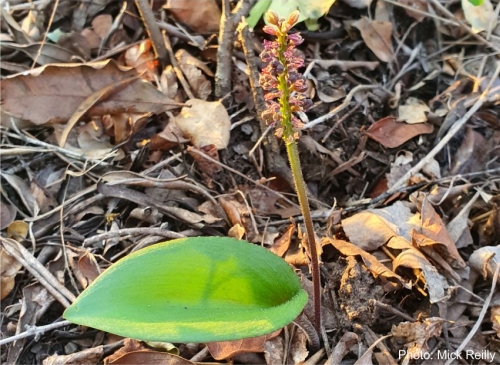
Description
Description
Deciduous bulbous plant occurring as solitary individuals or in loose clusters of a few bulbs growing together, 100–150 mm high. Leaves broadly lanceolate, 80–100 mm long by 30–80mm wide, green above, usually without spots, with a short pseudopetiole (false leaf stalk) which is either red or variously spotted and banded with red and white. The undersurface of the leaf is reddish towards the base and green towards the apex. The entire plant is covered with randomly scattered, short, erect hairs, with the exception of the raceme and flowers. Flowers are produced early in the summer growing season (September to November); usually one erect to slightly flaccid inflorescence per bulb is produced. The scape (main stalk) is red and hairy, the individual florets (small flowers) are attached to the raceme (main stalk) by a small pedicel (flower stalk). The individual flower buds are whitish, becoming green to greenish-red. Typical of the section Drimiopsis, the flowers are comprised of 6, hooded, incurved tepals (petals) that are shy, only opening slightly by way of the outer tepals (petals), whereas the inner tepals remain connate (touching) to conceal the inner floral parts. The flowers are strongly hyacinth-scented, especially during the heat of the day, when they are visited by small solitary bees and other flying insects. Seed capsules develop quickly after the senescence of the flowers and ultimately split open to reveal the dark brown to black, glossy, wrinkled seeds.
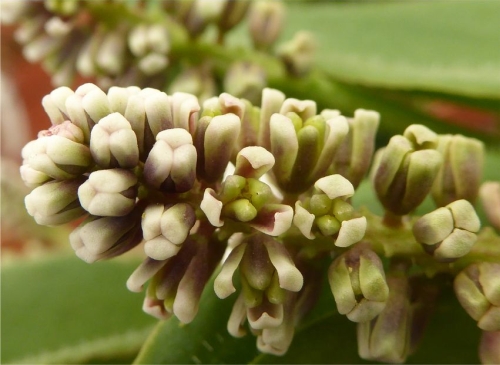
Conservation Status
Status
Ledebouria reillyana is endemic to Eswatini (formerly Swaziland), hence the species has not been included in the Red List of South African Plants. The species has not been assessed for the IUCN Red List of Threatened Species. It occurs over a very small area, but is protected inside the Mkhaya Game Reserve, where it occurs.
Distribution and habitat
Distribution description
Ledebouria reillyana is recorded only from the area in and near to the Mkhaya Game Reserve, north of Phuzamoja, Eswatini. The species occurs in low mixed broadleaf woodland under the shade of trees and amongst grasses.
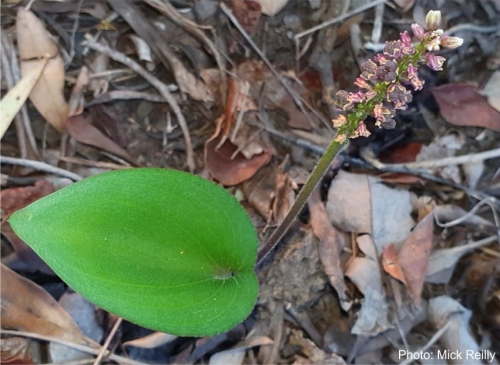
Derivation of name and historical aspects
History
This species was first discovered in eastern Eswatini by the married German botanist couple Drs Ute & Dietrich Müller-Doblies in 1981, while on a regular holiday visit to the Mkhaya Game Reserve. It was later formally named by them in 1997 as part of their partial revision of the genus. It was initially placed in the genus Drimiopsis when it was first named, in 2004 the species was shifted to the genus Ledebouria by Prof. John Manning in favour of a single genus approach to the taxonomy of the group. Manning (2012) also created three sections within the genus Ledebouria (sections: Ledebouria, Resnova & Drimiopsis), this species belongs in the section: Drimiopsis.
The genus Ledebouria is named in honour of the German-Estonian botanist, Professor Carl Friedrich von Ledebour (1785–1851). This species is named in honour of Elizabeth (Liz) Reilly (1943– ) The specific epithet contained a spelling error when U & D Müller-Doblies published the name in 1997; they included an extra ‘e’ before the ‘y’ in the epithet reilleyana. Elizabeth Reilly, spells her surname with only one ‘e’. This error in the spelling of the specific epithet is here corrected to Ledebouria reillyana in accordance with Art. 60.1 of ICN (2018).
Liz Reilly, together with her husband Ted Reilly, established Mkhaya Game Reserve in eastern Eswatini as a refuge for endangered lowveld species with a main focus on black and white rhino. They grew Mkhaya Game Reserve in size over time until its 10 200 ha expanse that it covers today. It is now a favoured tourism destination with a wide variety of wildlife, protected in perpetuity under the ownership of the not-for-profit Mkhaya Trust. Liz Reilly is also credited for discovering the plant Senecio mlilwanensis on the Reilly family farm Mlilwane, which was described by Prof. Robert Harold Compton (1886-1979), founder and director of the Compton Herbarium at Kirstenbosch and second Director of the Kirstenbosch National Botanical Garden, Cape Town, South Africa. Mlilwane became the first Protected Area in the Swazi Kingdom when Ted Reilly donated the farm to a Trust to perpetuate it for posterity in 1969; this equity attracted support from international benefactors, enabling it to grow to ten times its original size.
South Africa has 61 species of Ledebouria, with several more species occurring across southern, western, eastern and northeastern Africa and into India.
Ledebouria reillyana can be confused with its most closely related species L. linioseta, which has hairs in continuous longitudinal rows that trace the veins, as opposed to the former which has hairs scattered randomly. Ledebouria reillyana further differs from L. linioseta by the larger flowers which are more loosely arranged, as well as by the geographic distribution, with L. linioseta being restricted to Sekhukuniland in Mpumalanga province of South Africa, whereas L. reillyana is endemic to eastern Eswatini.
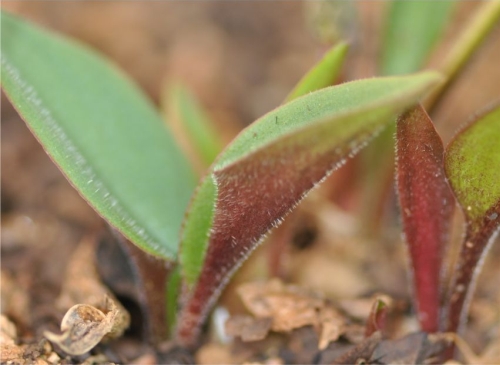
Ecology
Ecology
The flowers are shy and only open slightly when in full flower, although they are highly scented, with a sweet-spicy hyacinth-like scent which attracts a variety of insects. Small solitary bees (genus Nomia Fam. Halictidae) have been observed favouring members of section Drimiopsis, especially around midday when the scent is at its strongest. The pollinators have been seen to physically open the tepals with their forelimbs to gain access to the inner parts of the flowers (pers. obs. A. Hankey). The inflorescences are mostly erect to spreading at first, becoming more flaccid (floppy) with age; this may have something to do with optimizing visibility of the flowers to attract pollinators. The seed is small, drop-shaped and shiny black, with a wrinkled surface. Venter (1993) suggests that Ledebouria seeds may be distributed by water wash, which is likely after heavy summer thunderstorms, which are frequent across the area where this species occurs.
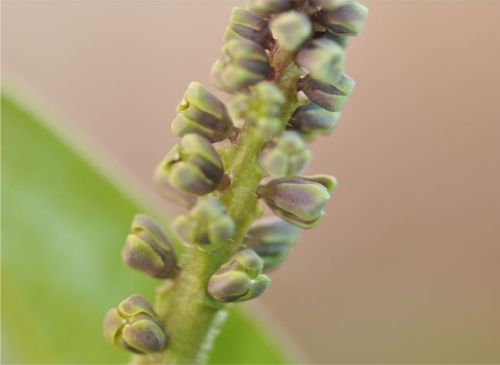
Uses
Use
Ledebouria reillyana is a very poorly known species; hence there are no references in the literature with regards to the uses of the species, however the genus Ledebouria has been cited as having been used medicinally for various purposes, including pregnancy, diarrhoea, influenza, backache, skin irritations, wound treatment, as well as lumbago. The genus is also reported as being poisonous, although it is also reported that Bushmen ate the bulbs of certain species, including L. revoluta and L. apertiflora. However, these may have been cooked or prepared in some manner to destroy the toxins, which is not specifically documented. Despite the fact that some large ungulates do browse the leaves, the entire genus should be regarded as being poisonous as a precaution.
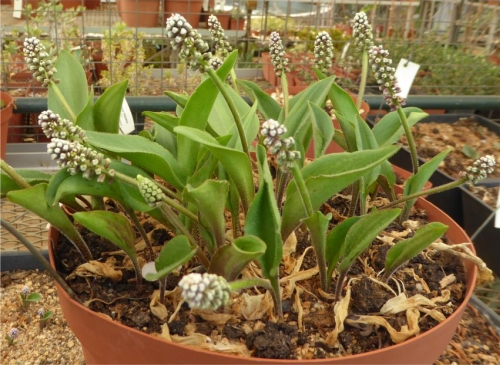
Growing Ledebouria reillyana
Grow
Reilly’s African hyacinth is very easily cultivated in gardens, although it is better suited to containers due to its small size. Plants are best cultivated in terracotta pots in full sun to semi-shade, in a warm climate. The bulbs should be planted in humus-rich loam or a well-drained, organic potting medium, with sifted kraal (cattle) manure or well-aged compost added. Watering should be done regularly during the summer growing season. The pots should be dried out during the dry winter rest period. They prefer a warm growing season, but can withstand cold temperatures in winter provided the soil is kept completely dry and the plants are dormant. During the dry winter dormancy period, the pots should be moved out of the rain and placed in a dry, cool area with good air movement. Watering can commence at the onset of warmer weather (August to September). Keeping the plants in strong sunlight, results in the darkest red leaf markings, which fade completely in the shade.
Propagation from seed is the best method of producing new plants. Seed must be sown fresh (cannot be stored for more than 1 year) in spring or summer, in deep seed trays filled with the sifted potting mixture detailed above. The seed can be sown on a firmly tamped surface and lightly covered with the same mixture, approximately 2–4 mm deep. The seed trays should be kept in a bright, warm position out of direct sunlight and kept damp for between 2 to 3 weeks, until germination has commenced. Once the seedlings have emerged, watering can be reduced. The seedlings can be pricked out into community pots or individual containers after their first year. Repotting should be done shortly before the onset of warmer temperatures. Flowering size bulbs can be attained after 2 to 3 years.
References
- Hankey, A.J. 2019. Proposed English common names for African hyacinths (genus Ledebouria). Plantlife SA, Vol 47:7 https://plantlifesouthafrica.blogspot.com/
- Hankey, A.J. 2020. Ledebouria linioseta (A.J.Hankey & P.D.Lebatha) J.C.Manning & Goldblatt (Hyacinthaceae). PlantZAfrica. Online. http://pza.sanbi.org/ledebouria-linioseta.
- Hankey, A.J., Buys, M.H. & Lebatha, P.D. 2008. Hyacinthaceae: Drimiopsis linioseta, a new species from the Sekhukhuniland centre of endemism, South Africa. Bothalia 38,1.
- IUCN. 2022. The IUCN Red List of Threatened Species. Version 2022-1. https://www.iucnredlist.org. Accessed on 23 August 2022.
- JSTOR Global Plants, Robert Harold Compton. https://plants.jstor.org/stable/10.5555/al.ap.person.bm000001611. Accessed 14 July 2022.
- Legends and legacies of Africa, Ted Reilly, conservation legend of Eswatini (Swaziland). https://legendsandlegaciesofafrica.org/tedreilly.php. Accessed 13 July 2022.
- Manning, J.C. 2012. Hyacinthaceae: new combinations in Ledebouria. Bothalia 42,1: 47, 48.
- Manning, J.C., Goldblatt, P. & Fay, M.F. 2004. A revised generic synopsis of Hyacinthaceae in sub-Saharan Africa, based on molecular evidence, including new combinations and the new tribe Pseudoprospereae. Edinburgh Journal of Botany 60: 533–568.
- Müller-Doblies, U. & Müller-Doblies, D. 1997. A partial revision of the tribe Massonieae (Hyacinthaceae). Feddes Repertorium 108 (1–-2): 49–96.
- Turland, N. J. et al. (eds.) 2018. International Code of Nomenclature for algae, fungi, and plants (Shenzhen Code) adopted by the Nineteenth International Botanical Congress Shenzhen, China, July 2017. Regnum Vegetabile 159.
- Wikipedia. Carl Friedrich von Ledebour. http://en.wikipedia.org/wiki/Carl_Friedrich_von_Ledebour. Accessed 6 November 2018.
Credits
Andrew Hankey
Walter Sisulu National Botanical Garden
August 2022
Acknowledgements: the author thanks Hugh Glen for advice on the correction of the spelling error in the initial description; Liz and Cotts Reilly for contributions and facts about the Reilly family; and Mick Reilly for two photos (acknowledged on the photos), the balance of the photos are by the author.
Plant Attributes:
Plant Type: Bulb
SA Distribution:
Soil type: Loam
Flowering season: Spring, Early Summer
PH: Neutral
Flower colour: Green, Red
Aspect: Full Sun, Morning Sun (Semi Shade)
Gardening skill: Easy
Special Features:
Horticultural zones









Rate this article
Article well written and informative
Rate this plant
Is this an interesting plant?
Login to add your Comment
Back to topNot registered yet? Click here to register.